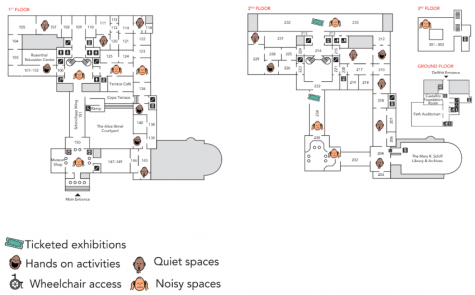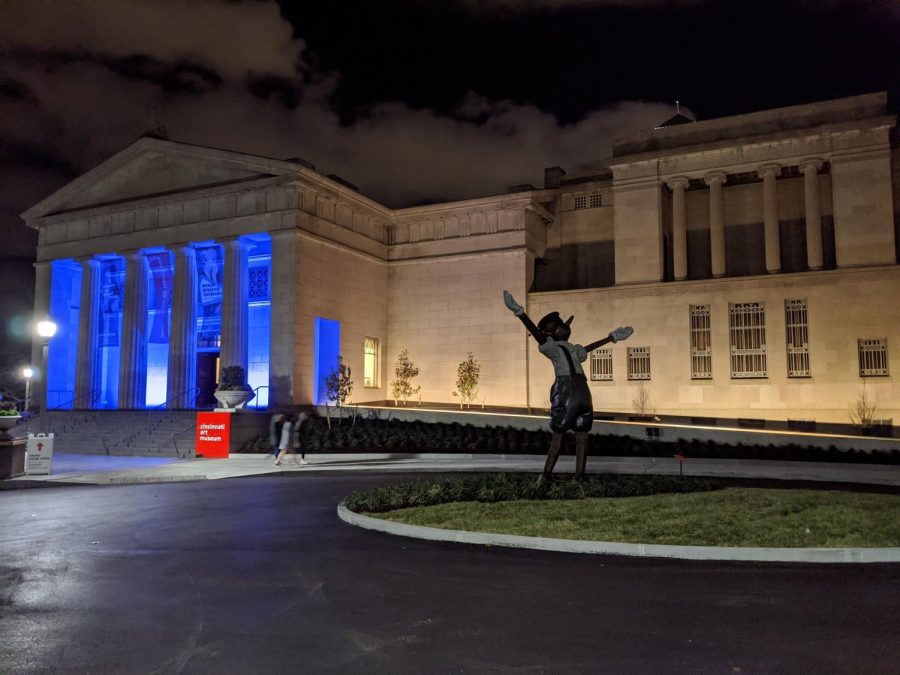Art museum works to create more inclusive experience
The Cincinnati Art Museum’s front entrance ramp stands illuminated at an Art After Dark event. Construction on the ramp began in late February, and it was officially unveiled on Oct. 17. The ramp is part of the museum’s accessibility initiative. With the addition of this ramp, older patrons and patrons with physical disabilities no longer have to solely rely on the wheelchair-accessible access located at the back of the museum.
Since 1881, the Cincinnati Art Museum has been a cornerstone of the Cincinnati community, both in the art it presents to the public and in its ability to provide a space for all Cincinnatians to share. Admission to the museum is free, which already makes it more accessible than many organizations, yet the Cincinnati Art Museum strives for even more openness and equity in experiencing its content.
Currently, the museum is reaching out to communities who may not have traditionally felt comfortable visiting an institution like an art museum, particularly people with disabilities who may have questioned whether they would be accepted and allowed to enjoy the work the art museum provides.
Sara Birkofer, the museum’s Manager of Accessibility and Gallery Programs, is tasked with designing an art museum that is more inclusive for those with disabilities.
“One of the main focuses of the strategic plan is, eliminating barriers to the museum, so physical, psychological, no matter what kind of barriers,” Birkofer said.
To ensure accessibility for the many communities that share Cincinnati’s art museum, the institution has embarked on many new initiatives and projects to create a more welcoming space.
One project the museum has undertaken to reach out to the Autistic community, as well as those who are particularly reactive to sensory elements, is Sensory Saturdays.
The museum is reimagined to fit the needs of those who are sensitive to touch and sound. On the fourth Saturday of every month, these patrons have the opportunity to come to a museum that specifically meets their sensory needs by providing safe spaces and reducing its overwhelming nature.
“An early part of the initiative was to create sensory-friendly guides, so identifying spaces within the museum where it’s really noisy which could be hard for people with sensory issues,” Birkofer said.
The museum has also developed maps that help families see which parts of the museum are quieter and less overwhelming than others.
Similarly, the program Memories in the Museum works with people who have Alzheimer’s, by providing specialized tours and activities for patrons with the memory loss disease. These events help bridge the gap between people with disabilities and their communities, showing that enjoying art is not just for one type of person.
The museum’s focus on accessibility has additionally been demonstrated with the recent creation of a new ramp at the museum’s front entrance. The addition of a ramp allows people with physical disabilities, including older patrons, to access to the museum without having to enter from the less welcoming back entrance.

Sensory Saturdays are only held once a month, but to guarantee constant inclusivity, the museum offers digital resources, including this map which pinpoints potential “noisy spaces,” for patrons who may become overwhelmed by sound or crowds. The museum also makes sensory guides and maps available to visitors at the front desk.
Furthermore, the art museum has recently won money from a grant to study ways to make the museum even more accessible.
The Cincinnati Art Museum is not the only local art museum to launch initiatives into increasing accessibility to their spaces. Similar efforts are taking place both at the Taft Museum and the Contemporary Arts Center.
“It’s a growing trend,” Birkofer said. These initiatives are exciting for Cincinnati’s arts community.
WHHS students can get involved with the art museum through their upcoming 10×10: Teen Art Expo. High school art students will have the opportunity to submit their own artwork for the chance for it to be displayed in an art show.
Of course, for those not interested in showcasing their artwork, the Cincinnati Art Museum maintains free admission for all, regardless of class, age and disability.
Your donation will support the student journalists of Walnut Hills High School. Your contribution will allow us to purchase equipment, cover our annual website hosting, printing costs and offset competition and conferences fees for students.





![Freshman choir students practice in class. “[The class] is almost like an army working together,” Anthony Nims, choir director, said.](https://whhscbox.com/wp-content/uploads/2025/10/freshman-choir.png)
![New theater teacher Mr. Mitchell leads his Stagecraft students through hands-on set-building techniques. “For me, [teaching] comes from the joy of learning, which is why I wanted to be in an educational setting.”](https://whhscbox.com/wp-content/uploads/2025/10/IMG_3248-451x600.jpeg)




